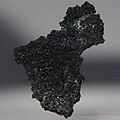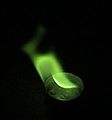Boron
| Boron | |||||||||||||||
|---|---|---|---|---|---|---|---|---|---|---|---|---|---|---|---|
| 5B | |||||||||||||||
| |||||||||||||||
| Boron in the periodic table | |||||||||||||||
| Appearance | |||||||||||||||
black-brown Boron, shown here in the form of its β-rhombohedral phase (its most thermodynamically stable allotrope)[1] | |||||||||||||||
| General properties | |||||||||||||||
| Name, symbol, number | boron, B, 5 | ||||||||||||||
| Pronunciation | /ˈbɔːrɒn/ | ||||||||||||||
| Element category | metalloid | ||||||||||||||
| Group, period, block | Template:Infobox element/group, 2, p | ||||||||||||||
| Standard atomic weight | 10.81(1) | ||||||||||||||
| Electron configuration | [He] 2s2 2p1 2, 3 | ||||||||||||||
| Physical properties | |||||||||||||||
| Phase | solid | ||||||||||||||
| Liquid density at m.p. | 2.08 g·cm−3 | ||||||||||||||
| Melting point | 2349 K, 2076 °C, 3769 °F | ||||||||||||||
| Boiling point | 4200 K, 3927 °C, 7101 °F | ||||||||||||||
| Heat of fusion | 50.2 kJ·mol−1 | ||||||||||||||
| [[Enthalpy of vaporization|Heat of Template:Engvar]] | 508 kJ·mol−1 | ||||||||||||||
| Molar heat capacity | 11.087 J·mol−1·K−1 | ||||||||||||||
| [[Vapor pressure|Template:Engvar pressure]] | |||||||||||||||
| |||||||||||||||
| Atomic properties | |||||||||||||||
| Oxidation states | 3, 2, 1[2] (mildly acidic oxide) | ||||||||||||||
| Electronegativity | 2.04 (Pauling scale) | ||||||||||||||
| [[ionization energy|Template:Engvar energies]] (more) |
1st: 800.6 kJ·mol−1 | ||||||||||||||
| 2nd: 2427.1 kJ·mol−1 | |||||||||||||||
| 3rd: 3659.7 kJ·mol−1 | |||||||||||||||
| Atomic radius | 90 pm | ||||||||||||||
| Covalent radius | 84±3 pm | ||||||||||||||
| Van der Waals radius | 192 pm | ||||||||||||||
| Miscellanea | |||||||||||||||
| Crystal structure | Template:Infobox element/crystal structure wikilink | ||||||||||||||
| Magnetic ordering | diamagnetic[3] | ||||||||||||||
| Electrical resistivity | (20 °C) ~106 Ω·m | ||||||||||||||
| Thermal conductivity | 27.4 W·m−1·K−1 | ||||||||||||||
| Thermal expansion | (25 °C) (β form) 5–7[4] µm·m−1·K−1 | ||||||||||||||
| Speed of sound (thin rod) | (20 °C) 16,200 m·s−1 | ||||||||||||||
| Mohs hardness | ~9.5 | ||||||||||||||
| CAS registry number | 7440-42-8 | ||||||||||||||
| History | |||||||||||||||
| Discovery | Joseph Louis Gay-Lussac and Louis Jacques Thénard[5] (30 June 1808) | ||||||||||||||
| First isolation | Humphry Davy[6] (9 July 1808) | ||||||||||||||
| Most stable isotopes | |||||||||||||||
| Main article: Isotopes of boron | |||||||||||||||
| |||||||||||||||

Boron ek chemical element hae jiske chemical symbol B, aur atomic number 5 hae.
Chhapa ke gallery[badlo | source ke badlo]
-
Crystalline Boron
-
Flame test
-
Kyselina trihydrogenboritá - H3BO3
Periodic table
| |||||||||||||||||||||||||||||||||||||||||
|---|---|---|---|---|---|---|---|---|---|---|---|---|---|---|---|---|---|---|---|---|---|---|---|---|---|---|---|---|---|---|---|---|---|---|---|---|---|---|---|---|---|
| H | He | ||||||||||||||||||||||||||||||||||||||||
| Li | Be | B | C | N | O | F | Ne | ||||||||||||||||||||||||||||||||||
| Na | Mg | Al | Si | P | S | Cl | Ar | ||||||||||||||||||||||||||||||||||
| K | Ca | Sc | Ti | V | Cr | Mn | Fe | Co | Ni | Cu | Zn | Ga | Ge | As | Se | Br | Kr | ||||||||||||||||||||||||
| Rb | Sr | Y | Zr | Nb | Mo | Tc | Ru | Rh | Pd | Ag | Cd | In | Sn | Sb | Te | I | Xe | ||||||||||||||||||||||||
| Cs | Ba | La | Ce | Pr | Nd | Pm | Sm | Eu | Gd | Tb | Dy | Ho | Er | Tm | Yb | Lu | Hf | Ta | W | Re | Os | Ir | Pt | Au | Hg | Tl | Pb | Bi | Po | At | Rn | ||||||||||
| Fr | Ra | Ac | Th | Pa | U | Np | Pu | Am | Cm | Bk | Cf | Es | Fm | Md | No | Lr | Rf | Db | Sg | Bh | Hs | Mt | Ds | Rg | Cn | Nh | Fl | Mc | Lv | Ts | Og | ||||||||||
| |||||||||||||||||||||||||||||||||||||||||
References[badlo | source ke badlo]
{{reflist}]
| Ii vigyan article ek chhota panna hae. Aap iske lamba karke Wikipedia ke madat kare saktaa hae. |
- ↑ Van Setten et al. 2007, pp. 2460–1
- ↑ Zhang, K.Q.; Guo, B.; Braun, V.; Dulick, M.; Bernath, P.F. (1995). "Infrared Emission Spectroscopy of BF and AIF". J. Molecular Spectroscopy 170: 82. doi:10.1006/jmsp.1995.1058. http://bernath.uwaterloo.ca/media/125.pdf.
- ↑ Lide, David R. (ed.) (2000). Magnetic susceptibility of the elements and inorganic compounds, in Handbook of Chemistry and Physics. CRC press. ISBN 0849304814. http://www-d0.fnal.gov/hardware/cal/lvps_info/engineering/elementmagn.pdf.
- ↑ Holcombe Jr., C. E.; Smith, D. D.; Lorc, J. D.; Duerlesen, W. K.; Carpenter; D. A. (October 1973). "Physical-Chemical Properties of beta-Rhombohedral Boron". High Temp. Sci. 5 (5): 349–57.
- ↑ Gay Lussac, J.L. and Thenard, L.J. (1808) "Sur la décomposition et la recomposition de l'acide boracique," Annales de chimie [later: Annales de chemie et de physique], vol. 68, pp. 169–174.
- ↑ Davy H (1809). "An account of some new analytical researches on the nature of certain bodies, particularly the alkalies, phosphorus, sulphur, carbonaceous matter, and the acids hitherto undecomposed: with some general observations on chemical theory". Philosophical Transactions of the Royal Society of London 99: 33–104. http://books.google.com/books?id=gpwEAAAAYAAJ&pg=PA140#v=onepage&q&f=false.
- ↑ 7.0 7.1 "Atomic Weights and Isotopic Compositions for All Elements". National Institute of Standards and Technology. Retrieved 2008-09-21.
- ↑ Szegedi, S.; Váradi, M.; Buczkó, Cs. M.; Várnagy, M.; Sztaricskai, T. (1990). "Determination of boron in glass by neutron transmission method". Journal of Radioanalytical and Nuclear Chemistry Letters 146 (3): 177. doi:10.1007/BF02165219.



